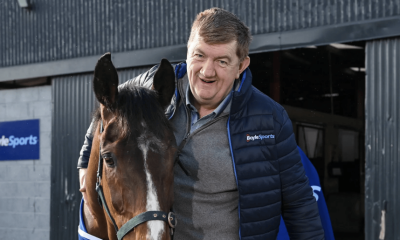Larkspur continues his quest for the perfect way to beat the bookie
In last month’s Racing Ahead we concluded the series on the elements from a typical racecard that can be used for ‘bettor’ purpose in devising your own horse racing system and to pinpoint potential winners. Regular readers and system enthusiasts will have realised that the series has revealed nothing that is altogether new. I make no apologies for this. The laws have been well established and precedents set insurmountably in stone. We have been given our commandments, whether we choose to follow the rules or not is another matter.
Form: Is your intended selection a winner, or did it place last time out?
Fitness: Is the horse fit – running between 7 and 28 days since its last run?
Conditions: Is the horse a course and/or distance winner?
Betting: Is the horse in the top third of betting market?
Ratings: Is the horse at the top of the handicap or form ratings i.e. the top third?
I say the top third for the last two factors as the optimum race numbers should be between 8 and 14 runners. Therefore, in an 8 or 9 runner race it is the top three in the betting/ratings to consider; in a 10, 11 or 12 runner race the top 4, and for a 13 or 14 runner race the top 5.
The reader may wish to introduce other factors e.g. going, beaten favourites, trainer form or course record, speed ratings etc. But I offer the above five considerations as these are common to all racecards and the aspiring system builder can work around and from these. Do not be fooled by the simplicity of what we are considering, there really is no need to over complicate things, you don’t want to be spending too much time on the mechanics of any system. The best systems have all been relatively easy to use: Fineform, Curtis, Racing Ahead Super Systems and dare I say it the Larkspur Method.
So, were there any winners in February that could readily have been spotted by adopting the methodology which we will now call the RaceCheck mind set, in order to give it a proper Racing Ahead working title?
On Saturday 8th February Glen’s Melody (Warwick 2.05) won the OLGB.com Mares Hurdle at even-money. Not a great price but Willie Mullins‘ mare was a winner last time out, ran 28 days previously, was a previous winner at the course, the top-rated horse in the race and the betting market favourite. On the same card Royal Player won for Philip Hobbs at 11/4 in the last race, beating the Paul Nicholls trained favourite Vivaldi Collonges by 26 lengths. The latter did not feature in the first two in Racing Post betting forecast (5 runner race) and had run 38 days previously when finishing sixth, also the horse had yet to register a win. On the same day you could have found Kim Bailey’s Harry Topper in the Denman Chase. You would have had to stretch the rules a little here as he was one place out in the betting; only race favourite Al Ferof was almost as ‘well in’ but he hadn’t raced for 44 days. The fitness thing is very important. I know, horses come out and win after months off the track but even with the proven top class performers you are relying on the trainer having the horse fit and ready to do itself justice. ‘He’ll come on for the run…’ How many times have you heard that little chestnut? It’s almost on par with football’s ‘Over the moon, Jim…’ in its crassness. At Wolverhampton in the evening, John Potts, Caramack and Mica Mika all did the RaceCheck proud.
On Sunday 9th February you could have had Toubeera 5/1 (Exeter), Never Enough Time 7/2F (Leopardstown), Alumina 6/4F (Southwell), and Noble Citizen 5/2 (Southwell).
It could be a potential selection is identified that is slightly outside of the optimum set of rules. But rules are meant to be broken and it is by breaking rules that longer priced selections can be found, but the backer better beware that straying too far from the true path can lead to many more losers. It is a fine line to tread, but we will discuss this later in the article.
By straying a little from the ‘norm’ you could have taken a relatively safe position in the Rendlesham Hurdle at Haydock on Saturday 15th February. The market leader was Celestial Halo and the Paul Nicholls horse was priced at even-money with the rest nowhere in the market. The favourite had not raced for 77 days and, despite being a course and distance winner, we could reasonably take him on with both Mickie – who managed to tick all the RaceCheck boxes – and Seeyouatmidnight who had won his last three races but did not quite make the ratings. The warning from Paul Nicholls was stark: “I missed three weeks of work with him (Celestial Halo) because of an infection in his foot. But for that I wouldn’t have run him before Cheltenham, but I need to get another run into him to get him to maximum fitness for Cheltenham… and whatever he does he’ll improve for the run.” Now that is straight from the horse’s mouth and if a champion jumps trainer is telling you this then you had better listen. But most punters didn’t and Celestial Halo was sent off the 6/5 favourite, with Mickie at 5/1 and Seeyouatmidnight at 6/1. The latter named winning by 1 ¼ lengths from Mickie with the favourite 13 lengths further back in third. The genius that was Paul Nicholls’ representative told the racing press that their horse ‘needed the run’.
Okay, hindsight is a wonderful thing. In horse racing there are far too many people who claim to have found a winner after the event. However, Racing Ahead readers will know that we don’t do that kind of thing. After all, you’re hardly like to keep on buying a magazine that you don’t trust. No, you won’t pick every winner by adopting the RaceCheck mind set, but you will hopefully start to avoid too many losers. And as a starting point for any racing system I would readily argue it has its merits. But in order to really make your racing pay you have to occasionally break the rules and we will discuss this soon.
It’s all a ‘Con’ trick
Last month I reported on an interesting ‘snip’ that I had noticed when going through the results for the handicap ratings. It was the record of the top-weighted runner in amateur and conditional handicap hurdle races. It appeared that there might be something in backing the horse carrying the most weight (taking allowances into consideration) – not the official top rated runner, but the horse that actually carries the most weight in the race. I also decided that odds of at least 5/1 should come into play. After all, we shouldn’t really be trusting the ‘kids’ with our money. And this is a definite rule breaker. How often is the punter told not to bet in this type of event? It is one of the oldest racing maxims; and one that I have slavishly followed.
But, is there an angle here? It could be that the younger and less experienced jockeys might be more inclined to just sit tight and let the horse do its own thing, therefore bringing about a situation where the top rated runners show their true form. So far the results look encouraging, but it will take a lot longer for us to determine if there is any mileage in this method as a viable system. The table below records the efforts to date. Please note Campbonnais was joint topweight and the stake has been adjusted accordingly to take account of the fact that the other runner was also backed.
| Date | Horse | Race | S.P. | Result | Stake | Return | Prof/Loss | |
| 1 | 16 January 2014 | Kodicil | Market Rasen 4.00 | 12/1 | WON | £1.00 | £13.00 | £12.00 |
| 2 | 23 January 2014 | Campbonnais | Fakenham 2.00 | 12/1 | WON | £2.00 | £13.00 | £11.00 |
| 3 | 7 February 2014 | Loyaute | Kempton 1.30 | 7/1 | WON | £1.00 | £8.00 | £7.00 |
| 4 | 9 February 2014 | Kilavalley | Exeter 1.55 | 25/1 | 2nd | £1.00 | £0.00 | -£1.00 |
| 5 | 11 February 2014 | Wayne Manor | Cheltenham 2.55 | 8/1 | Lost | £1.00 | £0.00 | -£1.00 |
| 6 | 18 February 2014 | Chapelle Du Roi | Wetherby 1.45 | 9/1 | Lost | £1.00 | £0.00 | -£1.00 |
| 7 | 25 February 2014 | Summer Lea | Catterick 2.50 | 13/2 | WON | £1.00 | £7.50 | £6.50 |
| 8 | 27 February 2014 | Dovils Date | Ludlow 5.00 | 12/1 | Lost | £1.00 | £0.00 | -£1.00 |
| Returns | £9.00 | £41.50 | £32.50 | |||||
| Runners | 8 | Winners | 4 | Losers | 4 | 50% | ||
| Stakes | £9.00 | Returns | £41.50 | Profit | £32.50 | 361% |
Psychology of backing racehorses
Okay, so we have our RaceCheck mind set. At times, we can adapt it to highlight winners or come up with surprise packages such as the top-weighted Conditional Jockeys thing, but what is the true mind set required to – as the Americans might say – play the ponies? I found a chapter from a book called Pace Makes The Race by Howard G Sartin Ph. D. It is a US horse racing book from the 1990’s and the chapter entitled: The Psychology of Winning – An introduction to win therapy is available to download on the internet. The author points out that the most important statistic in horse racing is ‘the indisputable fact that only two per cent of racegoers are consistent winners.’ In order to be a winner you have to do the opposite of the 98% of losing punters, or so the theory goes.
So where does this leave us with our RaceCheck mind set? Could it be that by focusing on the tried and tested theories we are in the forbidden territory of the 98 per cent of losers? Let us look at the Seeyouatmidnight race again. The Sandy Thomson trained runner was having his third run over hurdles under proper rules. This is what I wrote in the Larkspur Newsletter:
SEEYOUATMIDNIGHT is 2/2 for Sandy Thomson and Ryan Mania and the 6yo gelding hosed up at Musselburgh by 9 lengths in a Class 2 event on his last start. He is totally unexposed and his trainer is in good form. But the race favourite is Celestial Halo who boasts the best form in the race by far.
On the evening before the race I didn’t know about Celestial Halo’s fitness issues, and by highlighting Seeyouatmidnight’s chances I was going against the grain so to speak. We had a RaceCheck that wasn’t too far from ticking all the boxes – he was a little low in the ratings but had only had two starts under rules. Therefore, we could take this deviation into account if we accepted that this was an improving horse that was worth taking a chance on upped in grade. To make matters easier for me the horse was a top-rated Larkspur Method selection. It was pretty much a pillar to post victory with Ryan Mania keeping his mount to the vanguard and really testing his opponents throughout. Only time will tell how good Seeyouatmidnight is, but on Saturday 15th February 2014 he was brilliant! The 98 per-centers would have been on Celestial Halo, my normally risk averse nature would have had me grabbing for the hedging bet slip. But I read Paul Nicholls words and took them on board.
Another example: George Margarson’s Rebellious Guest was highlighted as a ‘Star Performer’ in the February edition of the Larkspur Racing Review (which is available to download from my website) on the back of his win at Lingfield on 1st February. It appeared that being introduced to the all-weather had brought about a change in fortunes for the horse. Next time out over the same C&D (one mile) he couldn’t complete the hat-trick under Tom Queally which was disappointing. However, on the evening of writing this article Rebellious Guest had just won a race at Kempton over 1m2f at odds of 8/1, again ridden by Tom Queally. The Kempton race was contested by another Larkspur Newsletter winner – albeit a 2nd rated runner on his day – in Indian Jack who going for a hat-trick. There was also Shavansky who had run in Indian Jack’s Newsletter winning race at Lingfield on 8th February; he was given what I thought was a ‘considerate ride’ by Shelley Birkett and I wrote as much in the Racing Review. Indian Jack was sent off the 3/1F, and Shavansky was to be ridden by Andrea Atzeni. The Larkspur Method 2nd rated horse was Rebellious Guest. Tom Queally rode a fantastic race to win at odds of 8/1. Clearly, taking Shavansky’s losing run as a fine example, I am not a race reader and I will leave that side of things to those who have a better eye.
It is a very fine line to tread in going against the grain, or ‘against the crowd’ as Alan Potts might say, and it appears to fly in the face of the RaceCheck mind set. But if we want to really win then we have to align well-considered logic and a definitive system with a little of the adventurist spirit in order to get amongst the 2 percent of winning horse players. You won’t find this on your database or on the exchanges. it comes through hard work. Me – I haven’t got all the answers and I’m still a work in progress. I have my own preferred methods and systems that I rely on but I keep exploring the racecards and reworking things in order to get a better angle. Next month we will look at a something that I have coined the ‘Bounce Factor’… a method for highlighting potential winners at long odds. Happy racing!













